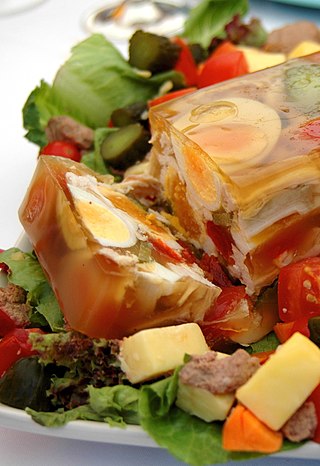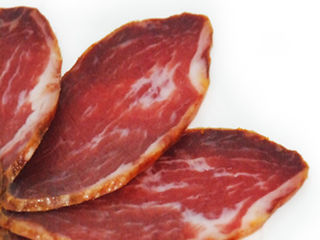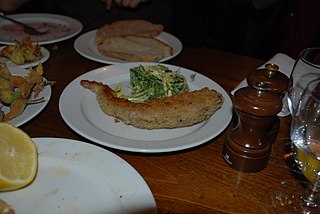Pickled pigs' feet is a type of pork associated with the cuisine of the Southern United States, Mexico, China, French Canada, and Scandinavia.
The feet of domestic pigs are typically salted and smoked in the same manner as other pork cuts, such as hams and bacon. It is common to preserve them in a manner very similar to home canning and processes for pickled vegetables; typically a saturation of hot vinegar brine is used. Such methods allow them to be preserved without the need for refrigeration until the jar is opened. They were once popular in American bars. [1]

Head cheese or brawn is a meat jelly or terrine made of meat. Somewhat similar to a jellied meatloaf, it is made with flesh from the head of a calf or pig, typically set in aspic. It is usually eaten cold, at room temperature, or in a sandwich. Despite its name, the dish is not a cheese and contains no dairy products. The parts of the head used vary, and may include the tongue but do not commonly include the brain, eyes or ears. Trimmings from more commonly eaten cuts of pork and veal are often used, and sometimes the feet and heart, with gelatin added as a binder.

A blood sausage, also known as a blutwurst sausage, is a sausage filled with blood that is cooked or dried and mixed with a filler until it is thick enough to solidify when cooled. Most commonly, the blood of pigs, sheep, lamb, cow, chicken, or goose is used.

Offal, also called variety meats, pluck or organ meats, is the internal organs of a butchered animal. The word does not refer to a particular list of edible organs, and these lists of organs vary with culture and region, but usually exclude skeletal muscle. Offal may also refer to the by-products of milled grains, such as corn or wheat.

Aspic or meat jelly is a savory gelatin made with a meat stock or broth, set in a mold to encase other ingredients. These often include pieces of meat, seafood, vegetable, or eggs. Aspic is also sometimes referred to as aspic gelée or aspic jelly. In its simplest form, aspic is essentially a gelatinous version of conventional soup.
Romanian cuisine is a diverse blend of different dishes from several traditions with which it has come into contact, but it also maintains its own character. It has been influenced mainly by Turkish but also a series of European cuisines in particular from the Balkan Peninsula and Hungarian cuisine as well as culinary elements stemming from the cuisines of Central Europe.

Pickling is the process of preserving or extending the shelf life of food by either anaerobic fermentation in brine or immersion in vinegar. The pickling procedure typically affects the food's texture and flavor. The resulting food is called a pickle, or, if named, the name is prefaced with the word "pickled". Foods that are pickled include vegetables, fruits, mushrooms, meats, fish, dairy and eggs.

Cypriot cuisine is the cuisine of the island of Cyprus.

Czech cuisine has both influenced and been influenced by the cuisines of surrounding countries and nations. Many of the cakes and pastries that are popular in Central Europe originated within the Czech lands. Contemporary Czech cuisine is more meat-based than in previous periods; the current abundance of farmable meat has enriched its presence in regional cuisine. Traditionally, meat has been reserved for once-weekly consumption, typically on weekends.

Peranakan cuisine or Nyonya cuisine comes from the Peranakans, descendants of early Chinese migrants who settled in Penang, Malacca, Singapore and Indonesia, inter-marrying with local Malays. In Baba Malay, a female Peranakan is known as a nonya, and a male Peranakan is known as a baba. The cuisine combines Chinese, Malay, Javanese, South Indian, and other influences.

Pig's ear, as food for human consumption, is the cooked ear of pig. It is found in several cuisines around the world.
An acquired taste is an appreciation for something unlikely to be enjoyed by a person who has not had substantial exposure to it. It is the opposite of innate taste, which is the appreciation for things that are enjoyable by most people without prior exposure to them.

A pig's trotter, also known as a pettitoe, is the culinary term for a pig's foot. It is used as a cut of pork in various dishes around the world, and experienced a resurgence in the late 2000s.

Cured pork tenderloin is found in various cuisines in Mediterranean Europe and South America. It is typically salted or brined then dry-cured or smoked.

Pig tail, also referred to as pigtail and pork tail, are the tails from a pig used as a food ingredient in many cuisines. Pig tails can be smoked, fried, or roasted in barbecue sauce.

Speck can refer to a number of European cured pork products, typically salted and air-cured and often lightly smoked but not cooked. In Germany, speck is pickled pork fat with or without some meat in it. In the Netherlands and Flanders, in Dutch, spek means bacon. Throughout much of the rest of Europe and parts of the English-speaking culinary world, speck often refers to South Tyrolean speck, a type of Italian smoked ham. The term speck became part of popular parlance only in the eighteenth century and replaced the older term bachen, a cognate of bacon.

Cuerito is pig skin from Mexican cuisine, Venezuelan cuisine and Spanish cuisine. Cuero is the Spanish-language word for skin, leather or hide, so cueritos means "little skins". They are usually pickled in vinegar and can be made with a spicy sauce. The vinegar can be seasoned with pineapple, dulce macho (piloncillo), cloves, peppercorns, chile de árbol and oregano. There are also family recipes.